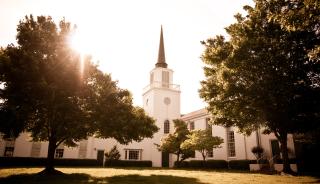Advertisement
In keeping with its mission for racial healing in the city of Tulsa, Oklahoma, All Souls Unitarian Church is moving from its current location in the wealthy, secluded Maple Ridge neighborhood of South Tulsa to a new site in the heart of downtown.
On Sunday, April 9, more than 80 percent of All Souls members at a congregational meeting voted to financially affirm a 2011 decision to move downtown. Church staff, including the Rev. Marlin Lavanhar, the congregation’s senior minister, strongly advocated for the relocation. “It’s a part of our sense of mission and vision to be a force of healing around the racial divisions in our city,” Lavanhar said.
For Lavanhar and other members of the All Souls community, the timing of the move is significant. If the capital campaign to raise funds for construction goes well, a new building downtown will be completed by 2021, which is the centennial of the congregation’s founding. That year will also mark 100 years since the infamous Tulsa race riot, in which white Tulsans killed as many as 300 black residents. The congregation was cofounded in 1921 by Richard Lloyd Jones, the owner and editor of the Tulsa Tribune newspaper, who most historians agree played a significant role in igniting the Tulsa race riot.
“We are hoping to be moved in right at the hundredth anniversary of our founding, and the riot, which I prefer to call a massacre,” said Lavanhar. “My hope is that in the public space inside the new building, we’ll tell the 100-year history of our community, from the massacre and the founders, through the civil rights movement and all that’s happened, good and bad, for visitors and members alike to see.”
In a phone interview on May 17 just hours before Tulsa police officer Betty Shelby was acquitted by a jury in the 2016 shooting death of Terence Crutcher, an unarmed black man, Lavanhar discussed the systemic racial imbalances in the city and spoke of risks involved in the move.
“Perhaps the biggest risk is funding,” he said. “Even though over 80 percent support it, 19 percent of a 2,000-member church is still a lot of people, and that 19 percent includes older, wealthier members, longtime folks.” He added, “We can pull this off, but only if we do this all together.”
All Souls has the largest membership of any local congregation in the Unitarian Universalist Association.
In 2011, three families gave the church a now-vacant, full city block in the East Village area, just south of the historically black Greenwood district, where the riot took place. The block is bounded by Frankfort and Kenosha Avenues and Sixth and Seventh Streets. Upon completion of the new building, All Souls will sit near a major exit off Highway 75, and just south of Interstate 244, both primary arteries for transportation in and through the Tulsa metro area.
For Steven L. Williams, the pastoral care chaplain at All Souls, moving downtown represents the church becoming “more diverse in all ways.” Williams, who is white and has long, deep ties to the Tulsa area, said, “We’re moving out of an almost entirely white neighborhood that’s also a wealthy neighborhood and an insulated community … [and we’re] moving into a place where people from every walk of life are just walking down the street.”
The move is not simply about being more diverse, Williams said. “The move embodies our collective desire and commitment to do the work of building the Beloved Community that our antiracist activists have worked toward for so long.” He continued, “We have to put ourselves, literally, in places to interact with people of all walks of life.”
Conversations around diversity, racism, and privilege are not merely intellectual exercises at All Souls but key to its mission and identity. At 11:30 a.m. on Sunday, April 23, two weeks after the vote, a visitor to the church encounters greeters directing people in the main hall of the church, with the same instructions: “Humanist hour to your right in the fellowship hall … contemporary service on your left.”
Contemporary service singer and song leader Dionne Lambert describes the simultaneous services as feeling like “multiple families living on top of each other.”
Joseph Boyd, a ministerial intern, and Bishop Carlton Pearson, both people of color, process into the sanctuary to lead the contemporary service. At the same time, Lavanhar and Williams, who are white, help lead the humanist hour. However, Lavanhar, Boyd, Williams, and other staff routinely serve as worship leaders at the contemporary service, too, as well as the 10 a.m. “traditional” worship.
It is apparent that each service has a target audience. The contemporary service is infused with black Christian tradition and Universalist theology. Many of the musicians and worship leaders, including Pearson, Lambert, and Executive Director of Worship David Smith, joined All Souls between 2008 and 2010, along with approximately 200 other Pentecostal Universalist Christians, most of them black. They were happy to have a worship home, but “wanted it to feel right,” Lambert said.
Lambert likens the simultaneous services to a couple deciding to get married when each already has their own home; when one moves into the home of the other, there’s a sense that the new place isn’t made for them. “I feel like I’m trying to fit in to what was already yours, your home,” she said. The move downtown excites her because she is thrilled to have “a new place that can truly feel like it belongs to everyone.”
Lambert added, “If we’re going to be the church we say we want to be, we have to be willing to notice. Our vision has been updated.”
